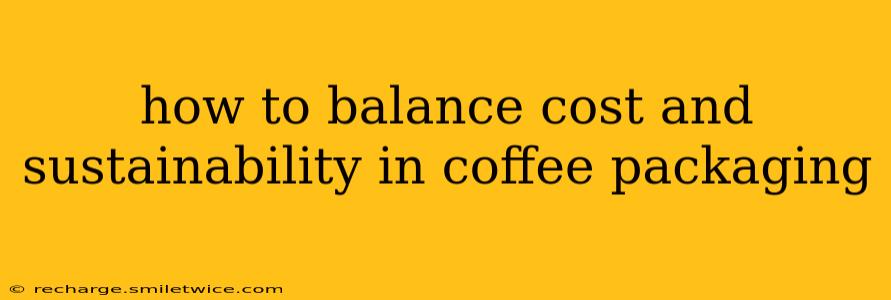The aroma of freshly brewed coffee is a pleasure many enjoy, but the journey from bean to cup often leaves behind a significant environmental footprint. Coffee packaging plays a crucial role in this journey, impacting both the product's quality and the planet's health. Finding the right balance between cost-effective packaging and sustainable practices is a challenge many coffee roasters face. This comprehensive guide explores various strategies to navigate this delicate equilibrium.
What are the Key Sustainability Concerns in Coffee Packaging?
The coffee industry generates substantial waste, with packaging contributing significantly. Traditional materials like plastic films and aluminum foil are cheap but non-biodegradable, leading to pollution and resource depletion. Therefore, a sustainable approach must prioritize:
- Reduced Material Usage: Minimizing packaging size while ensuring product protection.
- Recyclable and Compostable Materials: Choosing materials that can be easily recycled or composted at the end of their life cycle.
- Renewable Resources: Opting for packaging made from renewable sources, such as plant-based materials.
- Reduced Carbon Footprint: Considering the entire lifecycle of the packaging, including manufacturing, transportation, and disposal.
- Ethical Sourcing: Ensuring the materials used are sourced responsibly and ethically.
How Can I Reduce Packaging Costs Without Sacrificing Sustainability?
Balancing cost and sustainability requires a strategic approach that goes beyond simply choosing the cheapest option. Here's how you can achieve both:
1. Optimize Packaging Design for Efficiency:
- Minimalist Design: Reduce unnecessary embellishments and focus on functional design. This lowers material usage and printing costs.
- Smart Sizing: Choose the smallest package size that adequately protects the coffee and minimizes wasted space.
- Lightweight Materials: Use thinner but strong materials whenever possible, reducing material costs and transportation weight.
2. Explore Sustainable and Cost-Effective Materials:
- Recycled Paper and Cardboard: A readily available and cost-effective option that's easily recyclable. Look for certifications like FSC (Forest Stewardship Council) to ensure responsible sourcing.
- Bioplastics: Plant-based plastics offer a more sustainable alternative to petroleum-based plastics, though their costs can vary. Assess lifecycle impacts carefully.
- Compostable Films: These offer a completely biodegradable option, often made from plant starches or other renewable materials. However, widespread composting infrastructure is essential for their effectiveness.
- Reusable Packaging: While requiring a significant upfront investment, reusable containers can significantly reduce long-term costs and environmental impact. Explore partnerships with customers or a deposit-return system.
3. Source Materials Responsibly:
- Local Sourcing: Reduces transportation costs and emissions, making the supply chain more efficient and sustainable.
- Negotiate with Suppliers: Building strong relationships with suppliers can lead to better pricing and access to sustainable options.
What are the Different Types of Sustainable Coffee Packaging?
Several sustainable packaging options are available, each with its own pros and cons:
1. Paper-Based Packaging:
This is a widely used and readily recyclable option. Consider using recycled paper with FSC certification.
2. Bioplastic Packaging:
Made from renewable resources like corn starch or sugarcane, these offer a biodegradable alternative. However, the composting infrastructure must be in place for effective decomposition.
3. Compostable Packaging:
These materials break down completely in industrial composting facilities, leaving behind no harmful residue. Ensure the packaging is certified compostable.
How Can I Educate My Customers About Sustainable Coffee Packaging?
Transparency is key to engaging your customers in your sustainability efforts.
- Clearly Label Packaging: Highlight the use of recycled or sustainable materials and provide clear recycling instructions.
- Communicate Your Sustainability Initiatives: Share your company's sustainability goals and progress on your website and social media.
- Educate Customers on Proper Disposal: Provide clear information on how to recycle or compost the packaging.
FAQs about Sustainable Coffee Packaging:
Is sustainable coffee packaging always more expensive?
Not always. While some sustainable materials may have higher upfront costs, they can offer long-term savings through reduced waste management expenses and a positive brand image. Optimization of design and sourcing can also help control costs.
How can I find suppliers of sustainable coffee packaging?
Numerous suppliers specialize in eco-friendly packaging materials. Online searches and industry directories can help you locate suitable options based on your requirements and budget.
What are the best practices for recycling coffee packaging?
Always check local recycling guidelines as they vary. Generally, paper-based packaging is widely recyclable, while bioplastics and compostable options require access to specialized composting facilities.
By carefully considering these factors and implementing strategic approaches, coffee roasters can successfully balance cost-effectiveness with environmental responsibility, producing high-quality coffee in a way that protects both the bottom line and the planet.
